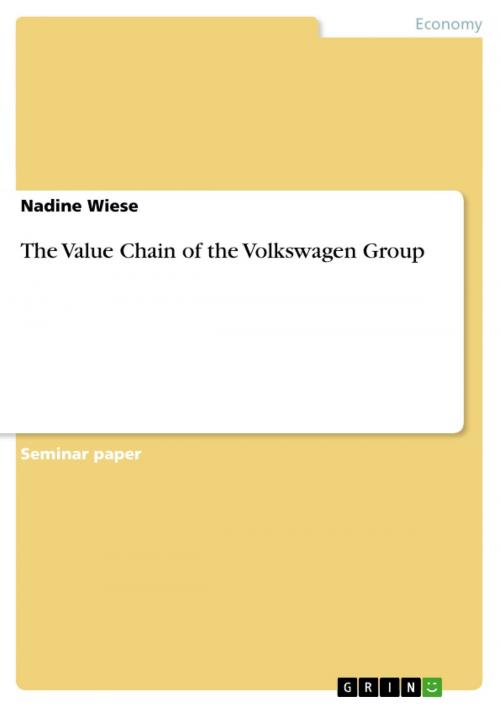| Author: | Nadine Wiese | ISBN: | 9783640467853 |
| Publisher: | GRIN Publishing | Publication: | November 9, 2009 |
| Imprint: | GRIN Publishing | Language: | English |
| Author: | Nadine Wiese |
| ISBN: | 9783640467853 |
| Publisher: | GRIN Publishing |
| Publication: | November 9, 2009 |
| Imprint: | GRIN Publishing |
| Language: | English |
Seminar paper from the year 2008 in the subject Business economics - Business Management, Corporate Governance, grade: 1,0, University of the West of England, Bristol (Bristol Business School), course: Strategic Management, language: English, abstract: The Volkswagen Group - from a company providing affordable cars for the German people to a global group producing broad-range models including premium vehicles for upper-classes. The success of the today's VW AG began in 1937 when VW was founded with the intention to provide affordable cars for the German people. After years of developing further models, acquisitions of other car manufacturers such as Audi and SEAT, and starting international operations, the Volkswagen Group has become the largest automobile manufacturer in Europe and one oft the leading car producers worldwide. Today there are almost 50 production plants in Europe, America, Asia and Africa. (Datamonitor 2008) The Volkswagen AG consists of two divisions. Next to the Financial Services Division there is the Automotive Division that develops vehicles and engines, produces and sells passenger cars, commercial vehicles, trucks, buses, vans, pick-ups and campers. Brands that are part of the VW Group include: VW, Audi, SEAT, Lamborghini, Skoda, Bentley and Bugatti. (Datamonitor 2008) Concentrating on the Automotive Division, the Volkswagen Group's strategy is analysed by looking at its value chain. It is examined what is performed well, where strengths are that create value, and what might be improved.
Seminar paper from the year 2008 in the subject Business economics - Business Management, Corporate Governance, grade: 1,0, University of the West of England, Bristol (Bristol Business School), course: Strategic Management, language: English, abstract: The Volkswagen Group - from a company providing affordable cars for the German people to a global group producing broad-range models including premium vehicles for upper-classes. The success of the today's VW AG began in 1937 when VW was founded with the intention to provide affordable cars for the German people. After years of developing further models, acquisitions of other car manufacturers such as Audi and SEAT, and starting international operations, the Volkswagen Group has become the largest automobile manufacturer in Europe and one oft the leading car producers worldwide. Today there are almost 50 production plants in Europe, America, Asia and Africa. (Datamonitor 2008) The Volkswagen AG consists of two divisions. Next to the Financial Services Division there is the Automotive Division that develops vehicles and engines, produces and sells passenger cars, commercial vehicles, trucks, buses, vans, pick-ups and campers. Brands that are part of the VW Group include: VW, Audi, SEAT, Lamborghini, Skoda, Bentley and Bugatti. (Datamonitor 2008) Concentrating on the Automotive Division, the Volkswagen Group's strategy is analysed by looking at its value chain. It is examined what is performed well, where strengths are that create value, and what might be improved.















